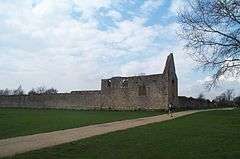Godstow
Coordinates: 51°46′48″N 1°17′56″W / 51.780°N 1.299°W
Godstow is a hamlet on the River Thames about 2.5 miles (4 km) northwest of the centre of Oxford. The ruins of Godstow Abbey, or Godstow Nunnery, are here.
Abbey
Godstow Abbey was built on what was then an island between streams running into the River Thames. The site was given to the foundress Edith, widow of Sir William Launceline, in 1133 by John of St. John and built in local limestone in honour of St Mary and St John the Baptist for Benedictine nuns; with a further gift of land from him, the site was later enlarged. The church was consecrated in 1139.
The abbey was again enlarged between 1176 and 1188 when Henry II gave the establishment £258 (which included £100 for the church), 40,000 shingles, 4,000 laths, and a large quantity of timber. This endowment is believed to be due to the site being the burial place of his mistress Rosamund Clifford.
The abbey was suppressed in 1539 under the Second Act of Dissolution.
The Abbey precincts were entered from the Wolvercote-Wytham road, which ran through the outer court. Here there was a two-storey main gatehouse which had one large gate for carts and a second smaller one beside it for foot traffic.
The site consisted of a guest house; a nunnery; an outer court containing a range of buildings; lodging for a priest; St Thomas's chapel which appears to have been used a church by the Abbey's servants; and the Abbey church, which contained cloisters along with associated buildings.
George Price Boyce, the Victorian watercolour painter associated with the Pre-Raphaelite art movement, visited and painted the nunnery in 1862.[1]
Rosamund Clifford
The abbey was the final burial place of the famed beauty Rosamund Clifford (died c. 1176), a long-term mistress of Henry II. Henry's liaison with Rosamund became known throughout court in 1174; it ended when she retired to the nunnery at Godstow in 1176, shortly before her death.
Henry and the Clifford family paid for her tomb in the choir of the convent's church at Godstow, and gave an endowment for it to be tended by the nuns. It became a popular local shrine until 1191, two years after Henry's death. Hugh of Lincoln, Bishop of Lincoln, while visiting Godstow, noticed Rosamund's tomb right in front of the high altar. The tomb was laden with flowers and candles, demonstrating that the local people were still praying there. Calling Rosamund a harlot, the bishop ordered her remains removed from the church. Her tomb was moved outside the abbey church to the cemetery at the nuns' chapter house next to it, where it could still be visited; but it was destroyed in the Dissolution of the Monasteries under Henry VIII.
Paul Hentzner, a German traveller who visited England c.1599, records [2] that her faded tombstone inscription read in part:
... Adorent,
Utque tibi detur requies Rosamunda precamur.
"Let them adore ... and we pray that rest be given to you, Rosamund."
Followed by a punning epitaph:
Hic jacet in tumba Rosamundi non Rosamunda,
Non redolet sed olet, quae redolere solet.
"Here in the tomb lies a rose of the world, not a pure rose;
She who used to smell sweet, still smells — but not sweet."
After the dissolution
The abbey was converted into Godstow House by George Owen. It was occupied by his family until 1645, when the building was badly damaged in the Civil War. After this damage, the building fell into disrepair and was used by the locals as a source of stone for their buildings.
During the 19th and 20th centuries, the ruined abbey was used for collecting livestock during the annual rounding up of animals on Port Meadow.
In Victorian times, Charles Dodgson (aka Lewis Carroll) brought Alice Liddell (aka Alice in Wonderland) and her sisters, Edith and Lorina, for river trips and picnics at Godstow.

By the Thames at Lower Wolvercote and Godstow is a 17th-century public house, The Trout Inn,[3] close to Godstow Bridge. The bridge, in two spans, was built in 1792, the southern span being rebuilt in 1892.
See also
References
Further reading
- Crossley, Alan; Elrington, C.R. (eds.); Baggs, A.P.; Blair, W.J.; Chance, Eleanor; Colvin, Christina; Cooper, Janet; Day, C.J.; Selwyn, Nesta; Townley, Simon C. (1990). Victoria County History: A History of the County of Oxford, Volume 12: Wootton Hundred (South) including Woodstock. pp. 311–313.
- Page, William, ed. (1907). Victoria County History: A History of the County of Oxford, Volume 2. Archibald Constable & Co. pp. 71–75.
- Royal Commission on Historical Monuments (1939). City of Oxford. HMSO.
- Sherwood, Jennifer; Pevsner, Nikolaus (1974). The Buildings of England: Oxfordshire. Harmondsworth: Penguin Books. p. 852. ISBN 0-14-071045-0.


